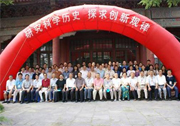| 英文摘要: |
In July 2012, we made on-the-spot investigations in Tongle, Gaoding, Dangchao and other locations in Sanjiang Dong Autonomous County of Guangxi Province. We found that tilted looms are in common use in the Dong area. Although their mechanical structure is simple, the looms are highly practical. Without a “hanging flower” harness attached they are typical multi-heddle & peddle looms, whereas when a “hanging flower” harness is attached they are a kind of special multi-heddle pedal loom with fewer pedals, called simple Jacquard looms. Because they are suitable for weaving plain cloth and twill cloth as well as brocade, they have a certain practicability in remote Dong settlements. On the basis of the on-the-spot investigations and analysis of related documents, we make a detailed analysis of the structure and features of the weaving techniques of the loom, especially the opening operation of its “hanging flower” harness. In addition, we discuss the origin of the loom’s technology and its correlation with Zhuang Minority bamboo machines. The tilted loom is considered to have originated in Han areas and then spread to minority areas and retained there, while Zhuang bamboo machines developed from Dong tilted looms. |





